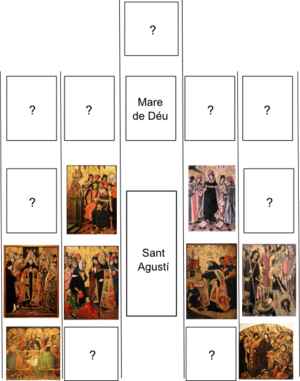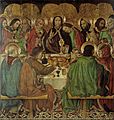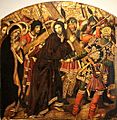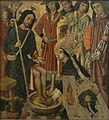Saint Augustine Altarpiece (Huguet) facts for kids
Quick facts for kids The Consecration of Saint Augustine |
|
|---|---|
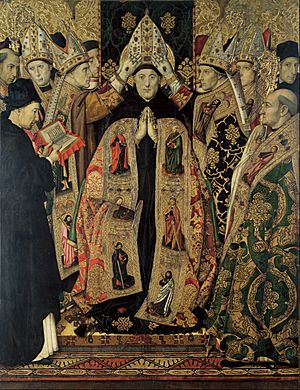 |
|
| Artist | Jaume Huguet |
| Year | 1460 |
| Medium | Tempera on wood |
| Location | Museu Nacional d'Art de Catalunya, Barcelona |
The Saint Augustine Altarpiece is a very old and important painting from Catalonia, a region in Spain. It was made using a special paint called egg tempera. Two main artists, Jaume Huguet and Pau Vergós, worked on it between 1462 and 1475.
This painting took a long time to finish, partly because of money problems. Huguet likely started the work, and other artists in his workshop, especially Pau Vergós, helped complete it.
A group of tanners (people who prepare animal hides) asked for this altarpiece to be made. They wanted it for the main altar in the Augustinian friary (a type of monastery) called Sant Agustí Vell in Barcelona, Spain.
Today, this large painting is kept at the Museu Nacional d'Art de Catalunya (MNAC) in Barcelona. It has been there since 1927.
Experts believe the altarpiece originally had more panels than the eight we see today. Seven panels are at the MNAC, and one is at the Museu Marès, also in Barcelona. These panels would have been set in a fancy, gold-covered wooden frame. This made it a grand retable, which is a large decoration behind an altar. Because of its size and beauty, it's considered one of the most important paintings from the 1400s in Catalonia.
Contents
What the Painting Shows
In 1463, the Tanners' Guild asked Jaume Huguet to create an altarpiece for their church in Barcelona. This painting is one of the biggest Catalan Gothic artworks ever made.
Because it was so large and the country was facing tough times, the altarpiece wasn't finished until 1486. Many artists from Huguet's workshop, including a member of the Vergós family, helped with the project.
Today, eight parts of this altarpiece still exist. Seven are in the MNAC museum, and one is in the Museu Marès. The main part, called 'The Consecration of Saint Augustine,' is especially well-painted. Many believe Huguet himself did most of this important section.
Style and Details
This painting shows a common style for Catalan art from that time. It has a shiny "gold ground" background. This gold background is decorated with patterns that look like fabric. These patterns are made using pastiglia, which is a type of stucco relief (raised decoration).
The gold relief is also used for the croziers (staffs carried by bishops) and the jewels on the mitres (special hats) and vestments (robes) worn by the figures.
The painting shows Augustine, who the church was named after, being made a Bishop of Hippo. This event happened in 395 AD in Roman North Africa. However, the people in the painting are wearing clothes from the 1400s, not from Augustine's time.
On the left, there's a figure without his full robes, reading a book. This is a "donor portrait" – a painting of someone who paid for the artwork. It's probably the head of the friary. Another friar's face, also looking like a portrait, can be seen peeking out on the right side.
How the Painting Was Made
Work on the altarpiece started on July 20, 1452. A carpenter named Macia Bonafé was hired to build the wooden structure for the altarpiece.
The plan was for the altarpiece to sit on a stone base. It would have doors on each side leading to the church's sacristy (a room where priests prepare). Bonafé also had to carve a statue of the Madonna (Mary) to go in a niche (a special alcove). He also had to create the heraldic lions, which were symbols of the tanners' guild.
Changing Artists
On the same day Bonafé got his building contract, the guild hired Luis Dalmau to paint the altarpiece once the structure was ready. But for unknown reasons, Dalmau never actually started painting.
So, on December 4, 1463, the painting job was given to Jaume Huguet. Huguet was paid in stages. He received one hundred and ten lliures (an old type of money) in February and July of 1464. After that, he was supposed to get fifty-six lliures every Christmas until he was paid in full.
Detailed Instructions
The agreement with Huguet was very clear and businesslike. He had specific instructions on how to proceed.
- First, he had to paint the four panels of the predella (the bottom part of the altarpiece). These panels were to show scenes from the Passion of Christ, based on a sketch Huguet had already shown the guild. This part was supposed to be finished by Christmas 1466.
- Huguet also had to paint figures of saints on the sacristy doors.
- He was responsible for coloring the statues and painting the heraldic lions.
Before he could start painting, Huguet had to show his drawings for approval. Both the guild and two painters (one chosen by the guild, one by Huguet) had to agree on the designs.
Since this was a very big project, it was expected that many assistants would help. However, the contract specifically stated that Huguet himself had to paint the heads and hands of the figures.
Delays and Completion
It wasn't until November 29, 1486, that the altarpiece was finally considered finished. This was twenty-three years after Huguet was first hired!
Records also show that Huguet wasn't paid exactly as promised. He didn't receive his full payment until 1488, when he was still owed 200 lliures.
The reasons for such a long delay are not fully known. However, there are a couple of ideas:
- One idea is that a powerful person called Constable Dom Pedro arrived shortly after Huguet's contract. He might have hired Huguet to paint another altarpiece, which would have taken priority.
- Another idea is that the tanners' guild lost interest or had money problems. This could have temporarily stopped the project.
Gallery
See also
 In Spanish: Retablo de San Agustín para niños
In Spanish: Retablo de San Agustín para niños


